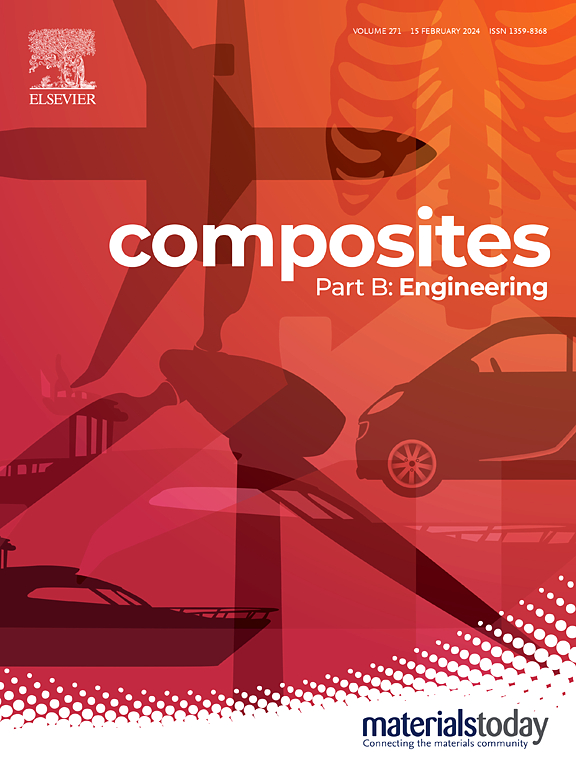Mechanism analysis of the effects of hygrothermal aging and random vibration on the performance of composite T-joints
IF 12.7
1区 材料科学
Q1 ENGINEERING, MULTIDISCIPLINARY
引用次数: 0
Abstract
Compared to investigations on the mechanical properties of composites at room temperature, this paper explored the effects of T-joint specimen, prepared with the room temperature curing paste adhesive J-349-3, on the pull-out and bending properties after exposure to both hygrothermal aging (HA) and random vibration (RV). The quasi-static pull-out and bending tests were carried out on the baseline specimen, the HA specimen, the RV specimen and the HA/RV specimen. The damage morphology, ultimate load and stiffness of the specimens were compared and analyzed, and scanning electron microscope (SEM) was used to reveal the influence mechanisms of HA and RV on the specimens. For the pull-out specimens, the ultimate load of the HA specimens increased by 14.4 %, while the ultimate load of the RV and HA/RV specimens decreased by 6.0 % and 19.9 %, respectively, compared to the baseline specimens. For the bending specimen, the environmental factors had a smaller effect (<10 %) on the ultimate load when the specimen was subjected to environmental factors. Compared to the performance of the composite laminate, the performance of the adhesive interface was more significantly influenced by the application of HA and RV. Additionally, there was a synergistic effect mechanism between the two combinations of HA treatment and RV on the effect of pull-out properties. Finally, the damage initiation and evolution of the specimen were further analyzed by the finite element model, and the validity of the model was verified by comparing the test results.

湿热老化和随机振动对复合材料t形接头性能影响的机理分析
通过对室温下复合材料力学性能的研究,探讨了用J-349-3室温固化膏状胶粘剂制备的t形接头试件在经受湿热老化(HA)和随机振动(RV)两种条件下的拉伸和弯曲性能的影响。对基线试件、HA试件、RV试件和HA/RV试件进行了准静态拉拔和弯曲试验。对比分析了试件的损伤形态、极限载荷和刚度,并利用扫描电镜(SEM)揭示了HA和RV对试件的影响机理。拔除后,HA试件的极限荷载比基线试件提高了14.4%,RV和HA/RV试件的极限荷载分别降低了6.0%和19.9%。对于受弯试件,环境因素对极限荷载的影响较小(10%)。与复合材料层合板的性能相比,HA和RV的应用对粘接界面性能的影响更为显著。此外,HA和RV两种组合处理对拔除性能的影响存在协同作用机制。最后,通过有限元模型进一步分析了试件的损伤起裂和演化过程,并通过对比试验结果验证了模型的有效性。
本文章由计算机程序翻译,如有差异,请以英文原文为准。
求助全文
约1分钟内获得全文
求助全文
来源期刊

Composites Part B: Engineering
工程技术-材料科学:复合
CiteScore
24.40
自引率
11.50%
发文量
784
审稿时长
21 days
期刊介绍:
Composites Part B: Engineering is a journal that publishes impactful research of high quality on composite materials. This research is supported by fundamental mechanics and materials science and engineering approaches. The targeted research can cover a wide range of length scales, ranging from nano to micro and meso, and even to the full product and structure level. The journal specifically focuses on engineering applications that involve high performance composites. These applications can range from low volume and high cost to high volume and low cost composite development.
The main goal of the journal is to provide a platform for the prompt publication of original and high quality research. The emphasis is on design, development, modeling, validation, and manufacturing of engineering details and concepts. The journal welcomes both basic research papers and proposals for review articles. Authors are encouraged to address challenges across various application areas. These areas include, but are not limited to, aerospace, automotive, and other surface transportation. The journal also covers energy-related applications, with a focus on renewable energy. Other application areas include infrastructure, off-shore and maritime projects, health care technology, and recreational products.
 求助内容:
求助内容: 应助结果提醒方式:
应助结果提醒方式:


